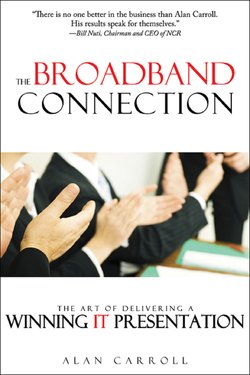Читать книгу The Broadband Connection - Alan Carroll - Страница 10
На сайте Литреса книга снята с продажи.
Оглавление3
The Structure of the Conversation
I don’t know what your destiny will be, but one thing I know: the only ones among you who will be really happy are those who have sought and found how to serve.
—ALBERT SCHWEITZER
As an IT professional presenter, you are managing a conversation. I use the word conversation rather than presentation because the definition of presentation suggests lower effectiveness. Presentation is defined as a way to exhibit, show, and display, whereas conversation implies a two-way flow of communication. People will remember more of what they do and say rather than what they hear.
A well-structured conversation is a critical component of your success as a presenter in the IT world. Currently, there are more than six billion people and most of them would have a difficult time understanding your IT conversation because of its abstractness, complexity, and (sadly) boring delivery.
One of the roles you must inhabit as Manager of the Conversation is that of a translator. Your first job is to plug in to the IT abstract world of complexity, then download content into your database of knowledge, to understand what the content means, and finally, translate and clearly deliver that abstract information to the listening audience. That’s easier said than done.
This chapter will show you how to structure your communication, which will increase your ability to be a clear and effective communicator. It is divided into three parts:
• The Introduction
• The Body
• The Conclusion
Communicating my meaning clearly is so important that I want to take the time to define some key words in the Structure of Conversation.
Structure is the arrangement of parts or elements of something complex and/or abstract. A tour guide serves as a useful analogy for structure. Think of yourself as standing in front of the audience, taking them on a tour of your IT subject matter. There is a purpose to the tour and the sites or key points they will see along the way.
Complex means something that is involved, intricate, elaborate, and often difficult.
Abstract means existing as an idea but not having physical or concrete existence. Abstract things may not be easy to analyze or understand. IT conversations can often be distinguished as complex and abstract.
Purpose is the reason for which something is done or for which something exists. Purpose is the aim, intention, and point behind the action taken.
Introduction
The introduction of a presentation contains several important elements, which include purpose, enrollment, key points, trial close, rapport building, credibility, logistics, and the transition to the body. For timing purposes, allow 15 percent of the presentation to be the introduction.
DEVELOPING THE PURPOSE
Clarity of purpose is the number one characteristic of the master communicator, but unfortunately, a statement of purpose is almost always missing in IT presentations.
Why is purpose so important? Because your power and decisions flow from being aligned with your purpose. If you are unclear about the purpose of the conversation, then the choices you make, the projection of your energy into the room, and the communication you create will lack vibrancy, clarity, and effectiveness.
Vibrant means spirited, lively, full of life, energetic, vigorous, vital, animated, sparkling, effervescent, vivacious, dynamic, stimulating, exciting, passionate, fiery, and sometimes feisty.
Purpose is your source of power. It energizes you and illuminates the data. It is much easier to manage the space of the room if you are standing in the light of purpose. However, most presenters are not always clear on the purpose of the conversation because they haven’t been trained in the distinction of purpose. They don’t realize how important clarity of purpose is to a successful presentation.
Imagine guiding a group of people down a dark tunnel. In one scenario, you are using a powerful flashlight; in the second scenario, you have a tiny candle. Clarity of purpose is like the flashlight; it illuminates the space.
Purpose follows understanding needs. The speaker needs to understand and diagnose the audience’s pain to prepare a conversation that will heal the pain. One difficulty the engineer faces is insufficient information about the customer in order to diagnose the problem accurately.
Here’s one of the first questions I ask when invited to do a presentation: “What is the audience’s need or pain for which my presentation is a solution?” I want to make sure they are hungry for the data food I will serve them.
A presenter, who is often a systems engineer, has an enormous number of product features, functions, and benefits on which to draw. But the engineer needs to know what the specific disease is in order to mix the correct prescription. The prescription is the medication or treatment that will cure the disease or reduce the pain of the customer.
What do I have to give that will be perceived as valuable? What do I have that will make a contribution and be of service to the audience?
The definition of sales is identifying the customer’s need/pain and how your features, functions, and benefits will solve it. If you can do that, it increases the probability the customer will buy your solution.
Making a presentation employs the same concept. The speaker has identified the customer’s need/pain and has prepared a conversation to address it.
